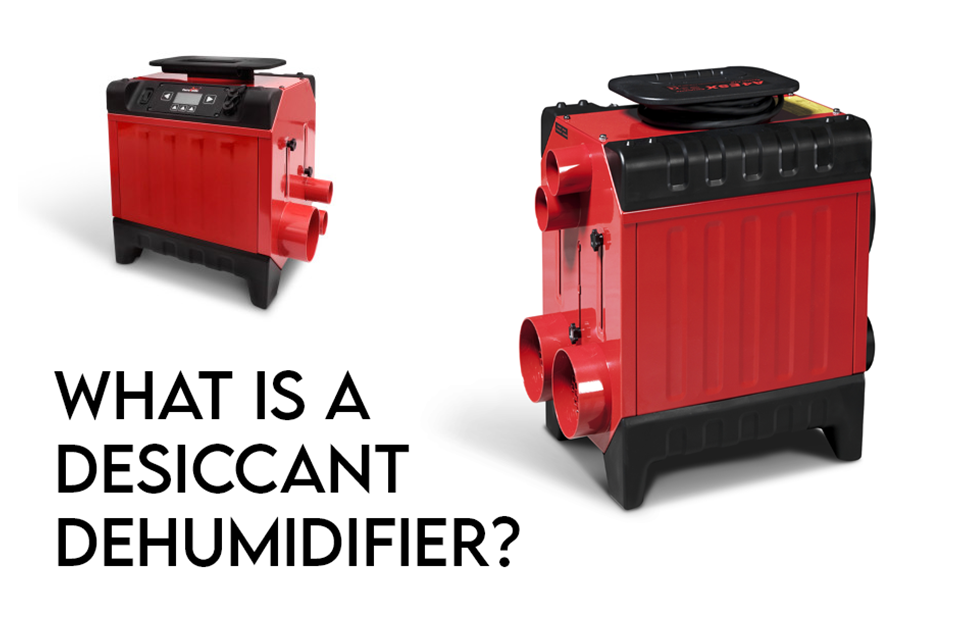
What is a Desiccant Dehumidifier?
Desiccant dehumidifiers are drying machines that help to remove moisture from the air or material after a leak or a flood. This method can be most helpful when you have sustained water damage.
Desiccant Dehumidifier
A desiccant dehumidifier is a type of air-based humidity control product that uses a drying material, known as a desiccant, to absorb moisture from the air. It works by passing ambient air through the desiccant material which absorbs any moisture present in the air. The resulting dry air is then passed through an exhaust system, thus reducing humidity levels within a specific area. Desiccant dehumidifiers are commonly used to reduce relative humidity levels in basements and crawl spaces, as well as other areas where high levels of moisture can be problematic. They can also be used to protect items such as electronics or documents from damage caused by excessive humidity.
Desiccant dehumidifiers come in two types: mechanical and chemical varieties. Mechanical models use a fan and filter system to draw outside air into the unit and pass it through the drying material before releasing it back outside with reduced humidity levels. Chemical models work similarly but rely on chemicals such as calcium chloride or silica gel instead of a fan or filter system for absorbing moisture from the ambient air. Both types of dehumidifiers have their advantages and disadvantages depending on user needs, so it’s important to compare them carefully before making a purchase decision.
What is a Desiccant Dehumidifier?
A desiccant dehumidifier is a type of dehumidifier that reduces moisture levels in the air. It uses a desiccant material, such as silica gel or activated alumina, to absorb moisture from the air. This type of dehumidifier works by passing air over the desiccant material, which absorbs excess moisture and reduces humidity levels in the area. Unlike traditional dehumidifiers, desiccant dehumidifiers do not add water vapor back into the air. They are an energy efficient way to reduce humidity levels in homes and businesses without relying on mechanical means like fans or compressors. As a result, they are often used when traditional methods cannot be employed due to space restrictions or other issues. Desiccant dehumidifiers can also be used for spot cooling and drying applications in areas such as basements and crawl spaces where high levels of humidity can cause damage to furniture or materials stored there.
Benefits of Desiccant Dehumidifiers
A desiccant dehumidifier is a type of dehumidifier that uses a desiccant material, such as silica gel, to absorb moisture from the air. This type of dehumidifier is often used in areas where other types of dehumidifiers may not be effective, such as areas with high humidity or large temperature fluctuations. Desiccant dehumidifiers are also known for their energy efficiency and quiet operation.
The main benefit of using a desiccant dehumidifier is its effectiveness in controlling humidity levels. The desiccant material absorbs moisture from the air and helps to create an environment with fewer allergens and bacteria, leading to improved indoor air quality. In addition, this type of dehumidifier can help reduce mould growth and protect vulnerable items such as furniture or electronics from damage due to excessive humidity levels.
Desiccant dehumidifiers are also more energy efficient than traditional compressor-based models since they do not need to compress the air to remove water vapour. This makes them ideal for use in locations where electricity costs are high or where there is limited access to power outlets. Furthermore, they operate quietly making them suitable for use in sensitive environments like bedrooms or offices without creating excessive noise pollution.
Where to Use Desiccant Dehumidifiers
Desiccant dehumidifiers are an effective way to reduce humidity levels in a variety of settings. They use a special desiccant material, such as silica gel, to absorb moisture from the air. This makes them well suited for areas with high humidity or low temperatures. Desiccant dehumidifiers are popular in industrial and commercial applications where temperature and humidity need to be tightly controlled. They can also be used in residential settings for controlling humidity levels in basements and other areas that may have extreme levels of moisture. Additionally, they are often used in climates that experience frequent storms and heavy rains, as they provide a more consistent level of dehumidification than other types of systems.
Advantages Over Other Dehumidifiers
A desiccant dehumidifier is a type of dehumidifier that uses a process known as adsorption to absorb moisture from the air. The most common material used in desiccant dehumidifiers is silica gel, which has high surface area and strong adsorption properties. As air passes over the desiccant material, water molecules are pulled into the material and stored until they are released back into the environment. This makes desiccant dehumidifiers particularly effective in low-temperature environments where other types of humidifiers may not be as efficient.
One of the major advantages of using a desiccant dehumidifier over other types of dehumidifiers is its energy efficiency. Since desiccants do not require condensation or evaporation cycles like other types of humidifiers, they can operate at much lower temperatures while still achieving similar levels of humidity control. This means that these machines use significantly less energy than traditional humidification systems, making them eco-friendlier and more cost-effective to run.
Another advantage is their ability to regulate humidity even when ambient temperatures drop below freezing point; this makes them ideal for cold climates where regular humidifying systems may struggle to function effectively.
Cost Considerations
One of the most important cost considerations when choosing a desiccant dehumidifier is the initial purchase cost. Desiccant dehumidifiers tend to be more expensive than other types of dehumidifiers due to their specialized components and energy-saving features. However, they are also more efficient and can save money in the long run by reducing energy costs. Additionally, they do not require frequent maintenance or replacement parts like other types of dehumidifiers, so this can save money over time as well.
Another factor to consider is the cost of operation for a desiccant dehumidifier. It is important to compare different models and brands in order to find one that fits within your budget constraints. In some cases, it may be worth investing in a higher-end model if it offers superior performance and efficiency over less expensive options. Additionally, many manufacturers offer discounts or incentives for purchasing multiple units at once or for signing up for a subscription service which can help bring down the overall cost of ownership.
Finally, it’s essential to factor in all associated installation costs when determining the price of a desiccant dehumidifier system. Professional installation will likely add an additional fee depending on complexity and location requirements; however, DIY installation kits are also available which could reduce overall costs significantly if you have experience with electrical wiring and plumbing systems.
Maintenance Tips
A desiccant dehumidifier is a type of dehumidifier that uses a specially designed material to reduce the amount of moisture in the air. This device is most often used in industrial settings, such as warehouses and factories, to protect stored goods from humidity damage. Desiccant dehumidifiers are also commonly used in residential basements and crawl spaces.
When it comes to maintenance tips for a desiccant dehumidifier, it is important to change the desiccant material regularly. The process usually involves carefully removing the unit’s panels or lid, scooping out any remaining desiccant material, and replacing it with new material. Depending on the type of machine you have, this may need to be done every few months or so depending on usage levels. Additionally, always make sure that your desiccant dehumidifier has enough ventilation around it as this will help ensure optimal performance and efficiency at all times. Lastly, check for any signs of wear and tear such as cracks or leaks as soon as possible and repair them before they cause further damage to your unit or other property nearby.
Conclusion: Summary & Benefits
In conclusion, a desiccant dehumidifier is an effective way of removing moisture from the air. It works by absorbing water vapor through a material such as silica gel or activated alumina, which can then be heated and dried to release the collected moisture as water vapor. This process is much more efficient than traditional methods such as refrigeration and condensation, making it suitable for use in areas with higher humidity levels. The main benefits of using a desiccant dehumidifier include improved air quality and energy efficiency, reduced costs associated with maintaining low humidity levels, and increased safety due to reduced risk of mould growth in moist indoor environments. All these factors make desiccant dehumidifiers an ideal choice for many applications. If you are looking for a reliable and easy way to reduce humidity in your space, consider contacting Prime Disaster Response today.

